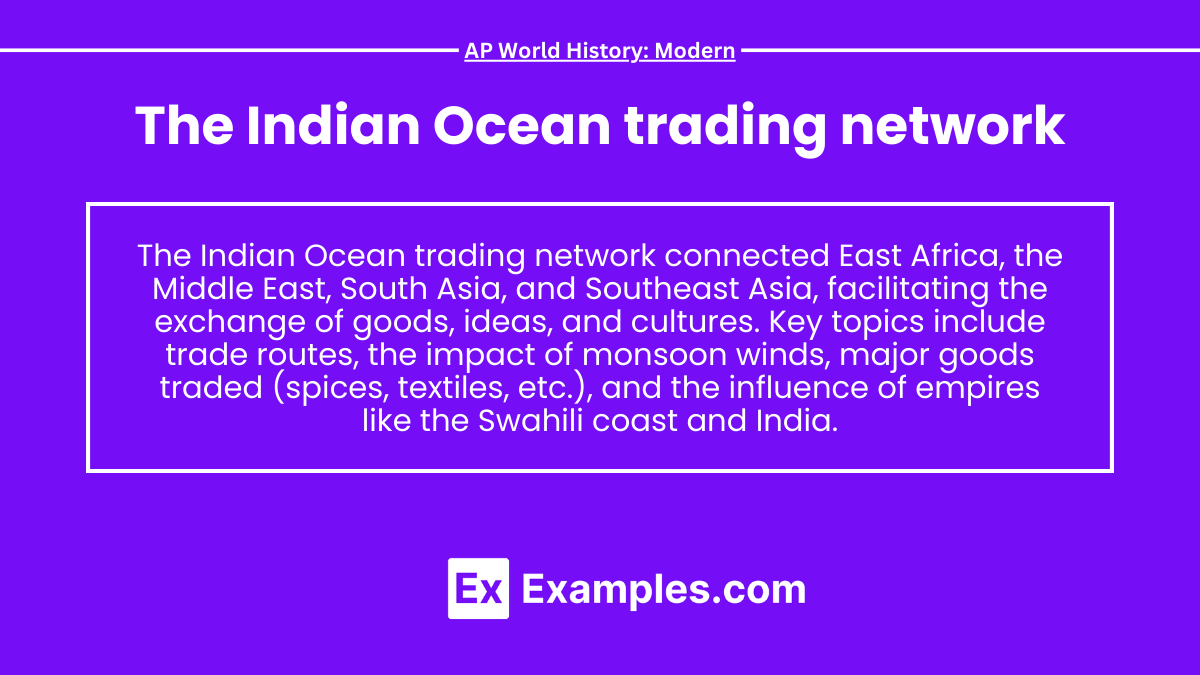The Indian Ocean trading network, one of the world's largest maritime trading systems, was active from the classical era to the early modern period (roughly 800 CE to 1500s). This complex trade system connected Southeast Asia, India, Arabia, East Africa, and the Persian Gulf, facilitating the exchange of goods, ideas, and cultures.
Free AP World History: Modern Practice Test
Learning Objectives
In studying "The Indian Ocean Trading Network" for AP World History: Modern, you should learn to identify the key trade routes, goods, and civilizations involved in this maritime network. Analyze the cultural, economic, and technological exchanges facilitated by the Indian Ocean trade, including the spread of religions, innovations in navigation, and interactions between diverse regions such as East Africa, South Asia, and Southeast Asia. Evaluate the impact of this trade network on the rise of powerful trading cities, empires, and global commerce, and explore how it shaped regional economies and contributed to the development of early globalization.
1. Geography and Routes
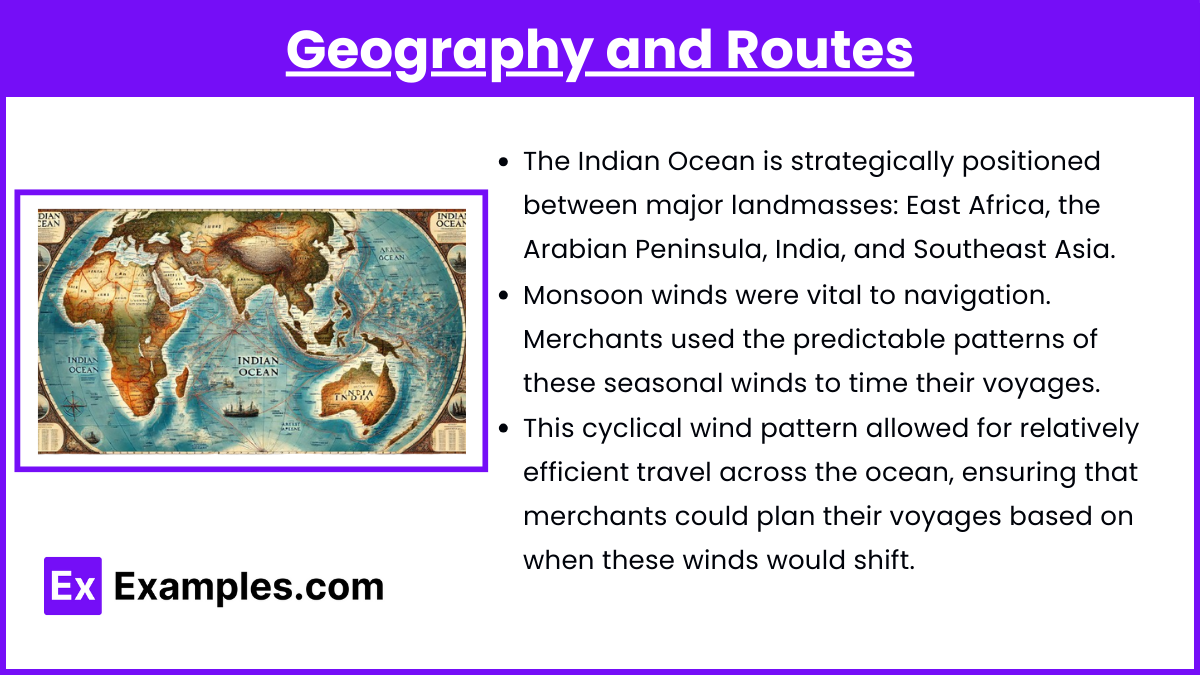
The Indian Ocean is strategically positioned between major landmasses: East Africa, the Arabian Peninsula, India, and Southeast Asia.
Monsoon winds were vital to navigation. Merchants used the predictable patterns of these seasonal winds (summer winds toward India and winter winds toward Africa) to time their voyages.
This cyclical wind pattern allowed for relatively efficient travel across the ocean, ensuring that merchants could plan their voyages based on when these winds would shift. As a result, regular and reliable trade routes developed.
Key trading cities included Calicut (India), Malacca (Southeast Asia), Mogadishu (East Africa), and Hormuz (Persian Gulf).
2. Goods Traded
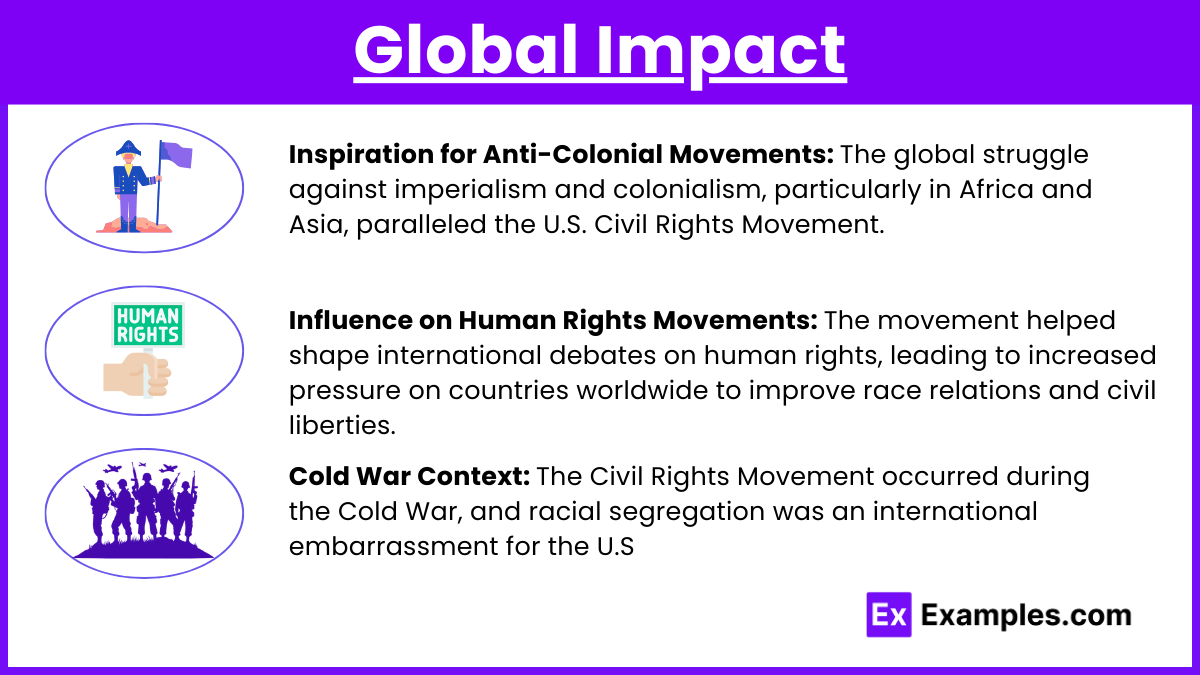
The Indian Ocean was known for the diverse types of goods exchanged, often in high demand across continents:
From Africa, goods such as gold, ivory, slaves, and exotic animal skins were exported to the broader world. These items were highly sought after in markets from India to the Arabian Peninsula.
From India, textiles (especially cotton), spices (such as pepper), and precious stones were important exports. India's position in the center of the Indian Ocean allowed it to act as both a source and a transit point for many goods.
From Southeast Asia, spices like cloves, nutmeg, and mace were particularly valued, especially in Europe. Timber and sandalwood were also shipped from this region.
The trade system was not purely focused on luxury items but also included bulk goods such as grains, rice, and timber.
3. Cultural Exchange
The Indian Ocean trade fostered significant cross-cultural interactions. Ideas, religions, and technologies were shared along with goods.
The Spread of Islam: Muslim merchants, in particular, played a dominant role in the Indian Ocean trade. Through their commercial activities, Islam spread to coastal regions of East Africa, India, and Southeast Asia. Cities such as Zanzibar, Mogadishu, and Malacca became key Muslim trading communities, and over time, Islam became a major cultural and religious force in these regions.
The Spread of Hinduism and Buddhism: Indian merchants were also instrumental in spreading religious ideas, particularly Hinduism and Buddhism, to Southeast Asia. This led to the creation of Hindu-Buddhist kingdoms like Srivijaya and Majapahit, where Indian cultural influences were integrated into local societies.
Technological Exchange: Maritime technologies such as the dhow (a traditional Arab sailing vessel) and the Chinese junk allowed for long-distance voyages. These vessels, equipped with advanced sail designs, were vital for navigating the vast expanses of the Indian Ocean. The exchange of navigational knowledge, including maps and sailing techniques, helped to make the Indian Ocean one of the most interconnected maritime regions in history.
4. Economic and Political Impact
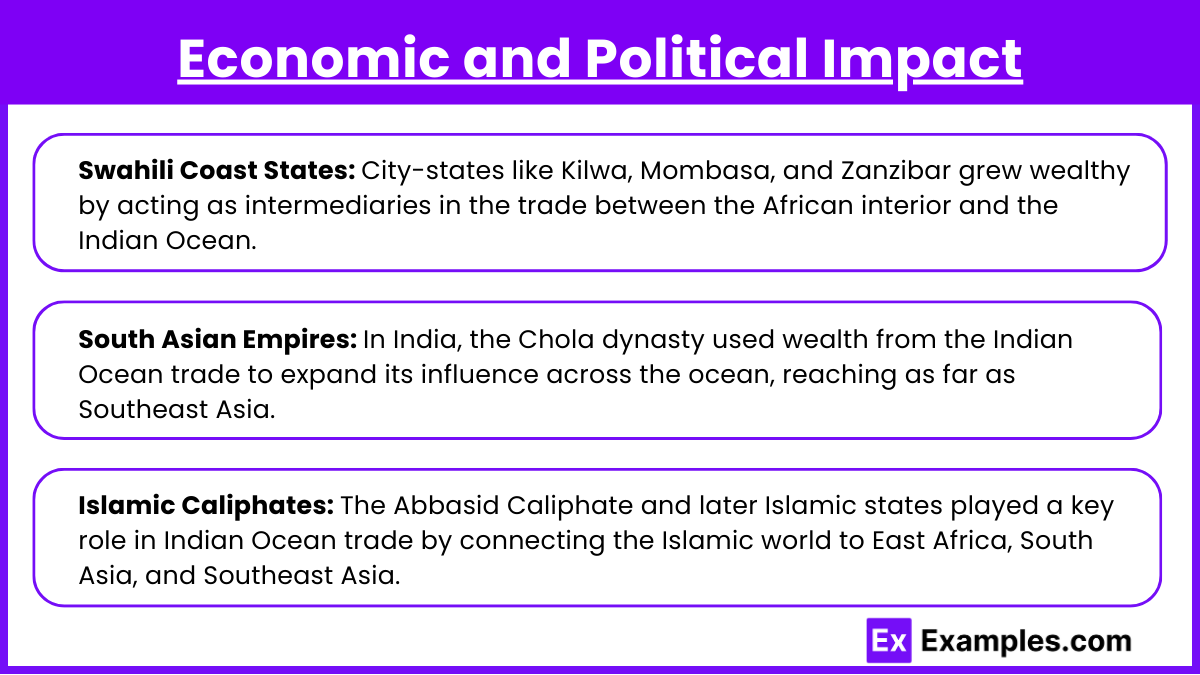
The Indian Ocean trade network was a critical factor in the rise of several powerful states:
Swahili Coast States: City-states like Kilwa, Mombasa, and Zanzibar grew wealthy by acting as intermediaries in the trade between the African interior and the Indian Ocean. These Swahili city-states exported goods like gold, ivory, and slaves while importing luxury items such as Chinese porcelain and Indian textiles. Their wealth allowed them to build impressive architectural works, blending African, Arab, and Persian styles.
South Asian Empires: In India, the Chola dynasty used wealth from the Indian Ocean trade to expand its influence across the ocean, reaching as far as Southeast Asia. South Asian empires were heavily involved in trade, exporting spices and textiles while importing goods from both the east and the west.
Islamic Caliphates: The Abbasid Caliphate and later Islamic states played a key role in Indian Ocean trade by connecting the Islamic world to East Africa, South Asia, and Southeast Asia. The Abbasid Caliphate, in particular, relied on Indian Ocean trade routes to import goods from distant lands, enhancing the cultural and economic connections between the Middle East and other regions.
5. Effects of European Arrival
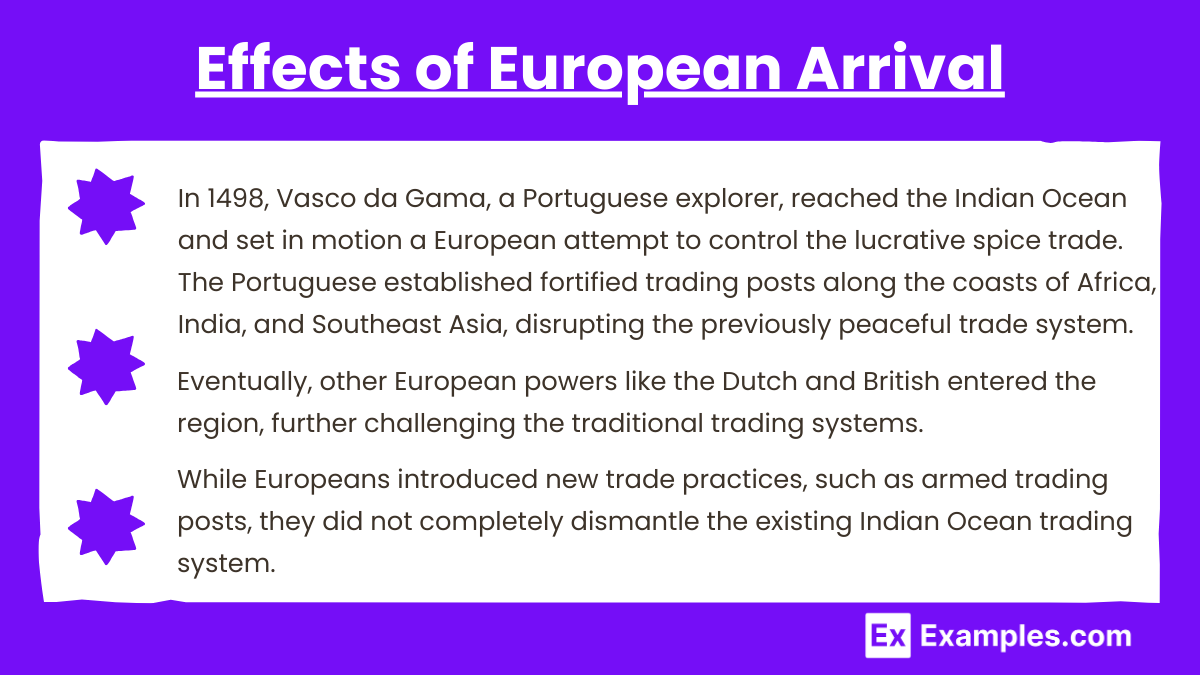
In 1498, Vasco da Gama, a Portuguese explorer, reached the Indian Ocean and set in motion a European attempt to control the lucrative spice trade. The Portuguese established fortified trading posts along the coasts of Africa, India, and Southeast Asia, disrupting the previously peaceful trade system. Although they never fully controlled the entire network, they sought to monopolize key routes, especially those involving the spice trade.
Eventually, other European powers like the Dutch and British entered the region, further challenging the traditional trading systems. The Dutch established control over key spice-producing regions, while the British later exerted influence through the East India Company.
While Europeans introduced new trade practices, such as armed trading posts, they did not completely dismantle the existing Indian Ocean trading system, which continued to operate with a mix of European and local powers.
Examples
Example 1: The Rise of the Swahili City-States
The Swahili Coast, located along East Africa, played a crucial role in the Indian Ocean trade. Cities like Kilwa, Mombasa, and Zanzibar became wealthy by acting as middlemen, exporting goods like ivory, gold, and slaves to other regions of the Indian Ocean while importing luxuries such as silk and porcelain from China. These city-states were culturally diverse due to the mix of African, Arab, Persian, and Indian traders, which resulted in a unique blend of languages, architecture, and religious practices, particularly the spread of Islam.
Example 2: The Influence of Srivijaya
The Srivijaya Empire, located in present-day Indonesia, controlled the Strait of Malacca, one of the most important chokepoints in the Indian Ocean trade network. This empire benefited from trade by controlling the passage of ships between India and China, taxing traders passing through their waters. Srivijaya exported spices like cloves, nutmeg, and sandalwood, and became a major center of Buddhist learning, with Chinese and Indian cultural influences merging in this region.
Example 3: Calicut as a Major Trade Hub
alicut, a port city on the Malabar Coast of India, became a thriving center of trade during the height of the Indian Ocean network. Known for its spices, especially pepper, Calicut attracted traders from across the Indian Ocean, including Arabs, Chinese, and later Europeans like the Portuguese. The city’s wealth came from its role as a key link in the spice trade, and it served as an entry point for luxury goods such as Chinese silk and Southeast Asian spices into the broader Indian and Middle Eastern markets.
Example 4: The Spread of Islam through Indian Ocean Trade
Muslim merchants were prominent participants in the Indian Ocean trade network, and their commercial activities facilitated the spread of Islam to new regions. Coastal areas of East Africa, such as Zanzibar and Mogadishu, saw the rise of Islamic communities, and by the 14th century, Islam had also spread to parts of Southeast Asia, particularly in cities like Malacca and Sumatra. The combination of religious diffusion and trade helped establish a shared culture and set of commercial practices across Muslim trading communities throughout the Indian Ocean.
Example 5: The Role of Chinese Merchants and the Ming Dynasty
Chinese merchants were significant players in the Indian Ocean trade network, exporting silk, porcelain, and tea in exchange for luxury items like spices, ivory, and pearls. During the early 15th century, the Ming Dynasty’s naval expeditions under Admiral Zheng He expanded China’s influence across the Indian Ocean, reaching as far as the Swahili coast. These voyages helped strengthen trade connections between China and various Indian Ocean ports, boosting Chinese exports and showcasing the empire’s naval power.
MCQs
Question 1:
What was the primary commodity exported from East Africa through the Indian Ocean trade?
A) Silk
B) Spices
C) Ivory and Gold
D) Porcelain
Answer: C) Ivory and Gold
Explanation: East Africa, particularly the Swahili coast, was a key player in the Indian Ocean trading network. The region was known for exporting valuable commodities like ivory and gold, which were highly sought after in other parts of the world, such as India, the Arabian Peninsula, and China. Additionally, slaves and animal skins were exported from East Africa. Silk and porcelain were Chinese exports, and spices came mainly from Southeast Asia, making options A, B, and D incorrect for this context.
Question 2:
Which of the following factors most contributed to the success of the Indian Ocean trading network?
A) The absence of European traders before the 15th century
B) The use of advanced maritime technology and navigation techniques, such as the monsoon wind patterns
C) The establishment of the Silk Road trade routes across Asia
D) The dominance of a single empire controlling the entire Indian Ocean
Answer: B) The use of advanced maritime technology and navigation techniques, such as the monsoon wind patterns
Explanation:
The Indian Ocean trading network relied on seasonal monsoon winds, enabling efficient long-distance trade. Advances in maritime technology, such as dhows and Chinese junks, further enhanced this network. No single empire controlled the entire region, emphasizing cooperative trade patterns, so option D is incorrect.
Question 3:
How did the arrival of Portuguese explorers affect the Indian Ocean trading network in the 15th and 16th centuries?
A) The Portuguese peacefully integrated into the existing trading system.
B) The Portuguese established a trading empire, seeking to monopolize key trade routes through the use of armed forces.
C) The Portuguese shifted the focus of trade from the Indian Ocean to the Atlantic Ocean.
D) The Portuguese introduced Buddhism to coastal regions of the Indian Ocean.
Answer: B) The Portuguese established a trading empire, seeking to monopolize key trade routes through the use of armed forces.
Explanation:
When the Portuguese, led by Vasco da Gama, entered the Indian Ocean in the late 15th century, they sought to control the lucrative spice trade by establishing a monopoly over key trade routes. They used military force and established fortified trading posts along the coasts of India, Africa, and Southeast Asia. Their arrival disrupted the existing peaceful trade networks, as they introduced aggressive tactics to dominate the region. They did not shift trade to the Atlantic, nor did they introduce Buddhism, so options C and D are incorrect. Option A is also incorrect because the Portuguese used force, rather than peaceful means, to integrate into the trade system.

